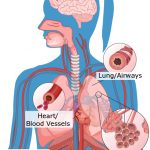Table of Contents
What is breathing problem?

Shortness of breath or dyspnea is the feeling of not getting enough air into the lungs. It worsens when you are physically active or you lie down flat. You may also have other symptoms (like cough or fever). Shortness of breath is also a signal for underlying health problems.
How bad is my shortness of breath or dyspnea?
Mild: You may experience loss of appetite, shortness of breath with minimal physical activities without affecting your daily life.
Moderate: Shortness of breath with moderate physical activities; fever. It may limit instrumental activities of daily life (like preparing meals, managing money, shopping, doing housework, and using a telephone).
Severe: Visit your doctor if you have shortness of breath at rest and coughing for 3 weeks or more. It may limit self-care activities of daily life (eating, dressing, getting into or out of a bed or chair, taking a bath or shower, and using the toilet).
How to manage mild shortness of breath?
Keep track of your symptoms using Ankr (myAnkr web portal or the Ankr app). It will help you describe the discomfort to your doctor or nurse.
- Quit smoking. It is the leading cause of COPD.
- Avoid breathing allergens and environmental toxins (chemical fumes or secondhand smoke).
- Avoid extremes in temperature. Activity in very hot and humid or very cold conditions may magnify the dyspnea caused by chronic lung diseases.
- If you have a medical condition that causes shortness of breath, discuss with your doctor what to do if your symptoms become worse.
- Exercise can help improve physical fitness and the ability to tolerate activity. Exercise — along with weight loss if you’re overweight — may help decrease any contribution to shortness of breath from deconditioning.
- Take your medications. Skipping medications for chronic lung and cardiac conditions can lead to poorer control of dyspnea.
- Regularly check your equipment. If you rely on supplemental oxygen, be sure your supply is adequate and the equipment works properly.
How to manage moderate and severe shortness of breath?
Seek emergency medical care if your shortness of breath is accompanied by chest pain, fainting, nausea, a bluish tinge to lips or nails, or a change in mental alertness — as these may be signs of a heart attack or pulmonary embolism.
What causes shortness of breath?
- Asthma
- Lung diseases (emphysema)
- Heart failure
- Panic attacks
- Allergies
- Pneumonia
- Lung Cancer
- A blood clot in the lungs, air leakage around the lungs, and scarring of the lung tissue
